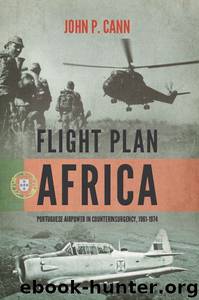Flight Plan Africa: Portuguese Airpower in Counterinsurgency, 1961-1974 (Wolverhampton Military Studies) by Cann John P

Author:Cann, John P. [Cann, John P.]
Language: eng
Format: epub
Tags: HISTORY / Military / Aviation
ISBN: 9781910777541
Publisher: Helion and Company
Published: 2015-05-18T21:00:00+00:00
The PAIGC logistic system relied on a fleet of these canoes plying the Inxanche and the other river systems of the Quitafine and Cantanhez peninsulas to supply its forces in southwest Guiné. (Source: PAIGC archives)
Defense of this territory was consequently difficult under the best of circumstances. The enemy did not have far to travel from his sanctuaries in Senegal and the Republic of Guinée to reach population centers. With such a short logistics tail that led over only partially challenged waterways from the south and overland routes in remote areas in the east, insurgent troops operated in concentrations almost anywhere in the territory. The Portuguese consequently found themselves in a defensive position, where Bissau, the capital and main port and city, was the center through which all power flowed to support the interior line represented by the frontier or border areas. Because the nature of the battlefield characterized the height of Clausewitzian friction, the absolute key to mobility was airpower. It would move troops to battle, support them in their fight, and bring them home afterwards. This support was accomplished with a relatively small cadre of specialized and highly trained aviators and support personnel and a varied assortment of obsolete aircraft.
The use of airpower in this theater began in 1963 as part of a military offensive and was successful as far as it went. However, it had its limitations for a number of reasons. Initially leadership of the war was divided between Brigadier Fernando Louro de Sousa, the commander-in-chief, and Comandante Vasco da Gama Rodrigues, the governor-general. While Rodrigues, a naval officer, was a forthright individual with a wealth of operational experience, Louro de Sousa was a staff officer with little practical experience in the field. Because of these two contrasting perspectives, the men clashed constantly, and the campaign against the PAIGC suffered accordingly. Rodrigues attempted to be practical, and Louro de Sousa clung to his theories of conventional war.15 This division of leadership created a fragmented approach that could not address the war effectively or successfully.
Brigadier Arnaldo Shultz, the commander-in-chief and governor-general during the period 1964 to 1968 decided to strike a defensive posture and to counterattack the PAIGC as it advanced in an attempt to regain control of lost areas. This strategy was doomed to failure, as it allowed the PAIGC a toehold within national territory and a relatively free hand with the population. Shultz did not see the population as a primary battleground, and while the PAIGC was establishing medical clinics, schools, village markets, and the like, Shultz ignored it. In fact, it was a key factor in the equation. Shultz pursued a military solution, indeed gambled on it, and the strategy proved a failure. The small territory was increasingly being overrun and controlled by the PAIGC in the face of his offensives. Early on the PAIGC was able to extend its influence into the northern and southern areas and deep into the east of Guiné in the chão manjaco (Manjaco ground). In 1965 it had begun to receive substantial military support from the communist bloc.
Download
This site does not store any files on its server. We only index and link to content provided by other sites. Please contact the content providers to delete copyright contents if any and email us, we'll remove relevant links or contents immediately.
| Arms Control | Diplomacy |
| Security | Trades & Tariffs |
| Treaties | African |
| Asian | Australian & Oceanian |
| Canadian | Caribbean & Latin American |
| European | Middle Eastern |
| Russian & Former Soviet Union |
The Secret History by Donna Tartt(16621)
The Social Justice Warrior Handbook by Lisa De Pasquale(11489)
Thirteen Reasons Why by Jay Asher(7788)
This Is How You Lose Her by Junot Diaz(5769)
Weapons of Math Destruction by Cathy O'Neil(5036)
Zero to One by Peter Thiel(4824)
The Myth of the Strong Leader by Archie Brown(4789)
Promise Me, Dad by Joe Biden(4447)
Beartown by Fredrik Backman(4415)
Stone's Rules by Roger Stone(4415)
How Democracies Die by Steven Levitsky & Daniel Ziblatt(4398)
The Fire Next Time by James Baldwin(4342)
100 Deadly Skills by Clint Emerson(4076)
A Higher Loyalty: Truth, Lies, and Leadership by James Comey(4032)
Rise and Kill First by Ronen Bergman(4012)
The David Icke Guide to the Global Conspiracy (and how to end it) by David Icke(3881)
The Farm by Tom Rob Smith(3872)
Secrecy World by Jake Bernstein(3782)
The Doomsday Machine by Daniel Ellsberg(3730)
